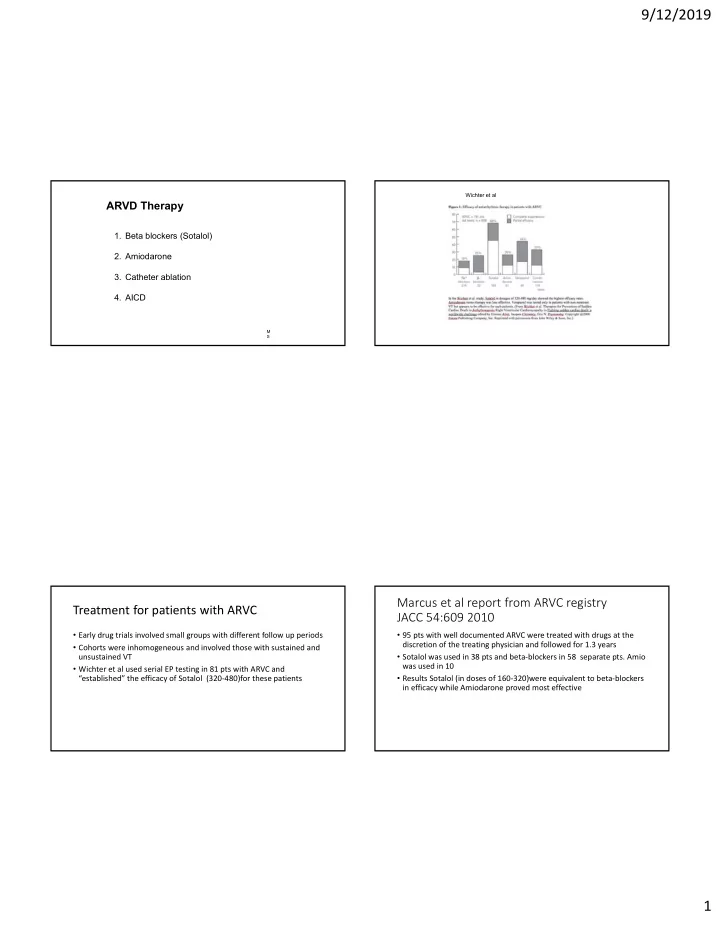

9/12/2019 Wichter et al ARVD Therapy 1. Beta blockers (Sotalol) 2. Amiodarone 3. Catheter ablation 4. AICD M S Marcus et al report from ARVC registry Treatment for patients with ARVC JACC 54:609 2010 • Early drug trials involved small groups with different follow up periods • 95 pts with well documented ARVC were treated with drugs at the discretion of the treating physician and followed for 1.3 years • Cohorts were inhomogeneous and involved those with sustained and • Sotalol was used in 38 pts and beta‐blockers in 58 separate pts. Amio unsustained VT was used in 10 • Wichter et al used serial EP testing in 81 pts with ARVC and • Results Sotalol (in doses of 160‐320)were equivalent to beta‐blockers “established” the efficacy of Sotalol (320‐480)for these patients in efficacy while Amiodarone proved most effective 1
9/12/2019 • 8 patients with recurrent refractory sustained VT were treated with Flecainide ( 50‐150 mg Combination bid) • All failed single drug therapy with beta therapy for blockers,Sotalol or Amiodarone treatment of • 4 failed prior Endocardial ablation • 3 failed prior epi/endocardial ablation VT in ARVC • 6/8 were arrhythmia free for a mean follow up of 35.5 months. 2
9/12/2019 Treatment? • No known pharmacotherapy to slow progression of RV dysfunction in human Heart Rhythm Society 2019 Shinkel metanalyses of ICD in pts with ARVC (Circ A&E 2013) • Included 610 pts from 18 studies for pts with ARVC for primary or secondary prevention • After 3.8 years annualized cardiac mortality was 0.9% and transplant rate was 0.9% Decongestant Therapy and • Annualized Inappropriate ICD interventions was 3.7%,ICD related Progression of Right complications include difficult lead placement 18.4%,lead malfunction 9.8% or displacement 1.4% Ventricular Structural 3
9/12/2019 Background Method‐Data Collection • All subjects underwent conventional M‐mode, 2‐D and color Doppler imaging using commercially available • Preload reducing agents (nitrates + diuretics) has shown promising (Vivid 5 or 7 GE Healthcare and Philips) ultrasound systems. results in preventing training‐induced development of ARVC in a murine model. • Offline analysis was performed using Syngo (Philips). Measurements including RVOT in parasternal long axis (PLAX) • We hypothesize that preload reducing therapy in patients with ARVC Proximal RVOT diameter in short axis (PSAX), RV‐end diastolic area (RVEDA), will slow progression of RV failure. fractional area change (FAC), tricuspid annular plane systolic excursion (TAPSE) • One of the main predictors of RVEF on CMR was found to be RV were performed in accordance with American Society of Echocardiography guidelines. All measurements were performed by one physician. Global Longitudinal Strain (RVGLS) on TTE • An independent experienced research sonographer blinded to treatment date performed strain analysis twice on all available echocardiograms. • Statistical analysis performed using paired t‐test. Shadi Kalantarian, MD, MPH Heart Rhythm Society 2019 Shadi Kalantarian, MD, MPH Heart Rhythm Society 2019 Heart Rhythm Society 2019 Method 2010 Revised Task Force Major Echo criteria • Design: Single center study (University of California San Francisco) of patients meeting 2010 Revised Task Force Criteria for ARVC. RVESA • Inclusion Criteria: Patients with ARVC in arrhythmia phase or with symptomatic RV RVEDA dysfunction. • Intervention: ISDN 10‐40 mg TID (at maximum tolerated dose) and hydrochlorothiazide‐spironolactone 25‐25 mg daily (RVEDA‐RVESA) X100 FAC= RVEDA • Data Collection: Retrospective chart review was performed for clinical information such as age at the time of treatment, anti‐arrhythmic treatment, genetic testing and presence of an ICD; history of VT classified as VT self‐terminated VT and VT requiring treatment Fractional Area Change PLAX RVOT ≥32 mm PSAX RVOT ≥36 mm (i.e. anti‐tachycardia pacing or defibrillation). (FAC) ≤33 % PLAX/BSA ≥19 mm/m2 PSAX/BSA ≥21 mm/m2 Shadi Kalantarian, MD, MPH Heart Rhythm Society 2019 Shadi Kalantarian, MD, MPH Heart Rhythm Society 2019 4
9/12/2019 RVGLS on TTE vs. RVEF on MRI Progression of RV dysfunction in a registry of ARVC patients • A total of 73 patients were enrolled: 33 (45%) at UCSF and 40 (55%) at University of Linkoping. • The average age was 39 ± 14 years old and 56% were men. • Each subject had a median of 3 serial ECGs and TTEs (range 2‐11 studies) available for analysis over a median follow‐up of 5.9 (IQR 3.5‐ 9.7) years . • Genetic testing identified known pathogenic mutations in 48.0% (n=35) of the cohort with plakophilin‐2 (PKP2) gene most commonly RVGLS is an independent predictor of RV function and RVEF on affected followed by desmoplakin (DSP), Desmoglein‐2 (DSG) and titin cardiac MR (TTN) Shadi Kalantarian, MD, MPH Heart Rhythm Society 2019 Shadi Kalantarian, MD, MPH Heart Rhythm Society 2019 Effect of Preload Reducing Therapy on RV Function in Patients with Echocardiographic changes in ARVC Registry ARVC Normal At baseline, On last follow up*on Treatment, p‐value** reference mean (SD) mean (SD) RVGLS, % >‐20% ‐14.76 (3.8) ‐14.71 (4.57) 0.98 RVEDA, cm2 11‐28 38.81 (9.4) 38.03(8.37) 0.79 RVOT PLAX, cm <3.2 4.54(1.42) 4.92(0.78) 0.39 RVOT PSAX, cm <3.6 4.56(0.78) 4.7(0.78) 0.62 RVFAC, % >32% 25.01 (5.44) 21.45(8.21) 0.26 LVEF, % >55% 61.50 (6.6) 60.33(5.54) 0.76 * Last follow up average 2.24 years (range 0.56‐5.36) ** p-value reported from two-tailed paired t-testRVGLS: RV systolic global longitudinal strain; RVFAC: RV fractional area change; RVEDA: RV end diastolic area; LVEF: LV ejection fraction; PLAX: RVOT in parasternal long axis ;PSAX: Proximal RVOT diameter in short axis. Shadi Kalantarian, MD, MPH Heart Rhythm Society 2019 Shadi Kalantarian, MD, MPH Heart Rhythm Society 2019 5
9/12/2019 Conclusion • Preload reducing agents show promising results in slowing RV enlargement and stabilizing RV function in patients with ARVC. • To our knowledge this is the first therapy that is showing possible disease modifying potential. Shadi Kalantarian, MD, MPH Heart Rhythm Society 2019 6
Recommend
More recommend